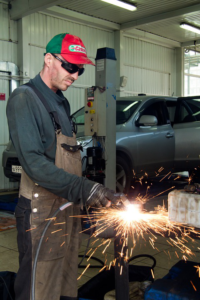
Classic car enthusiasts and restorers know the importance of the right kind of restoration work for their vehicles. After all, it should work on both an aesthetic and functional level.
Everything on your car eventually needs to be assembled, and that’s where welding jobs come in. They’re most useful for large structural jobs and body work. In fact, it’s possible that you’ve already run into some problems like a rust patch, a cracked panel, or even a puncture in your car’s body. Perhaps you’ve discovered a cracked muffler or a cracked chassis.
Fortunately, you can fix all these problems—and not to mention save valuable time and money—with welding, instead of replacing the parts. What’s more, welding gives you control over the repair process, allowing you to produce intricate work.
Let’s look at the different welding options you can work with for your auto project:
1. TIG Welding
Tungsten Inert Gas (TIG) is an arc welding technique that utilizes a tungsten electrode in order to create a solid weld and prevents contamination surrounding the weld puddle using a shielding gas. The process requires a thin welding rod to be fed into the arc manually, enabling the welder to fine-tune the parts as required.
TIG welding is great for finer projects where aesthetics is a priority since it provides a clean weld site with little to no metal material splatter. Since TIG welders have control over the equipment’s heat density, they can weld in thin metals (such as those required for auto body sheets) without a lot of distortion.
2. Stick Welding
A tried-and-true old-fashioned welding method is stick welding or Shielded Metal Arc Welding (SMAW). Just like TIG, stick welding also utilizes a filler metal material, but it’s more of a messy and quick welding process and not as precise. It’s ideal in situations where sturdy joints and functionality is a priority, instead of precision. Stick welding is ideal for aging, rusty, thicker metals.
If you’re looking to preserve original parts of your car project, stick welding is a good way to make them functional.
3. MIG Welding
A popular choice in repairing auto body parts, Metal Inert Gas (MIG) welding keeps things simple and clean as the welding wire is fed directly through the welder, making it a one-handed process. Plus, MIG welding is cleaner and quicker than most welding methods. It’s also much easier to operate.
MIG welding is your go-to welding method for several auto-body repairs since it can handle a wide range of metal thicknesses—including most steel and aluminum parts used throughout the car restoration project—without sacrificing clean appearance and strength.
Looking For Professional Welding Services in Wasilla, Alaska?
Get in touch with certified welders at PlasmaTech for your next auto project! They’ll assess the car parts and find the best welding method that suits your budget and needs.
